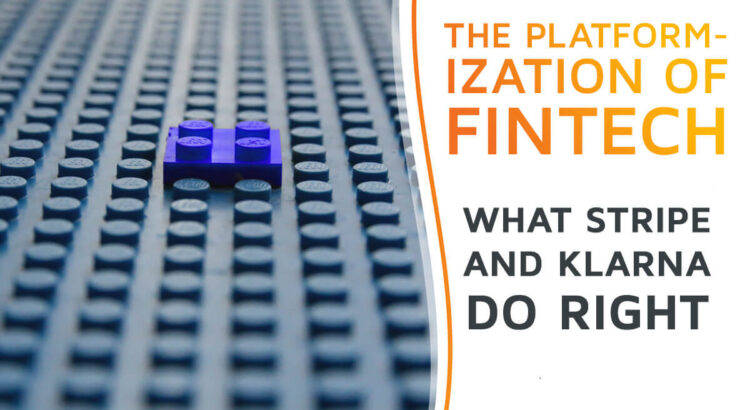
In the financial industry, we are never shy to celebrate a good rivalry. Neobanks compete with banks who compete with fintechs who compete with Google, Amazon or Apple who compete with each other (and WeChat). Yet, the industry has also become known for promising partnerships. Technical providers, fintech platforms, merchants, telcos etc. combine their resources and expertise.
I can relate: Where partners with different backgrounds support each other, it’s easier to create approach problems from different angles and overcome obstacles (shoutout to my co-founders here). Likewise, partnerships between fintech companies allow them to tackle new portions of the market and improve customer experience or services – and that’s often the goal. What’s more, where technological partners join forces, we can also see huge jumps in innovation regarding infrastructure. Those companies often lay the groundwork for other companies to utilize in their products and services.
For me, the recent co-op of fintech platform Stripe and Buy Now, Pay Later provider Klarna stands as a prime example of this later case. The cooperation of those two effectively presents a straightforward route to BNPL for single online shops and platforms. Online businesses just have to tie in the Stripe integration and their BNPL is basically ready to go.
However, this would not be as significant, if both Stripe and Klarna had not become known for their extensive service portfolio. Stripe acts as a payment facilitator for online marketplaces while, at the same time, being a fintech platform itself. It’s an expression of a trend some in the industry call the platformization of fintech.
What do I mean by that?
From the Platformization of E-Commerce…
Fintech’s platformization is just a subset of the overall platform-driven economy. Today, a majority of customers shops online regularly – the pandemic amplified the trend towards online purchases further. Typically, customers buy at digital marketplaces with many products and services rather than shops with a limited scope.
But they don’t do that simply out of convenience.
It’s also the result of the dynamics of an online economy that favors multi-vendor solutions. Many platforms with high online reach noticed that they could earn additional revenue by offering that reach to other merchants: “Leave us a fee or share of the revenue and your services can be accessed by more customers – deal?”
Of course, that would also be attractive for financial institutions. It could help them increase their potential number of customers – especially for those operating within a niche.
This impacts how customers relate to online financial service providers (or digital service providers as a whole). Data analytics enable businesses to cater the experience towards individual consumers and offer the right product in the right context. The result: Consumers are used to having a hyper-personalized experience (even though they might not even witness their shopping sessions as such).
What’s more, this puts pressure on companies to always offer the proper products at the proper time. For financial players, traditional banks, in particular, that’s tricky. Their value chain is no longer linear. Customers are ready to enter relationships with multiple financial businesses to fulfil their needs for payments, investments and mortgages.
I think Paolo Sironi, Global Research Leader Banking and Financial Markets at IBM, put it perfectly. He stated that the “customer-business relationship is the ‘new product’ that must be priced” in our digital, platform-based economy.
…to the Platformization of Fintech
So, how do financial companies position themselves to remain on track in today’s platform economy?
That depends on the company’s business model. Some companies build their own platforms to offer products and services in direct B2C or B2B. This includes BigTechs like Amazon with their business loans or Search Engines that acquired banking licenses.
With the concept of Embedded Finance rising in prominence, however, financial institutions take on the role of suppliers to external platforms as well – sometimes reluctantly so, as is the case of many traditional banks. Effectively, those financial institutions become what merchants become for marketplaces in e-commerce. For example, comparison portals like Check24 list financial product providers – but often offer customers to directly book the product in question. For this to work, the financial institution must act as a supplier.
Yet, when we say “platformization of fintech”, we should not only concentrate on the actual platforms and products but also on underlying operations. Here many process-focused fintech companies make their appearances: Payment processors, e-wallet suppliers, KYC service providers, fintech-as-a-service platforms etc. It’s where much of the innovation happens. And this takes us straight back to the Stripe/Klarna partnership.
What Stripe Does Right
As we can see, financial platforms very much rely on business partnerships. That is if they not build and operate their infrastructure in-house (which may have advantages). But infrastructure providers can become a bottleneck for growth, as vendor lock-in might happen. And the more functional and scalable the underlying technological infrastructure for a platform’s products is, the better.
In my opinion, Stripe understands those three things very well: The need for partnerships to innovate and quickly deliver to a diverse online market.
Then the importance of a functional infrastructure for financial processes.
And, most prospectively, the truth in the saying: “If you can’t beat them, join them.” Klarna is not just a partner of Stripe, but also a rival. By adding the Klarna services to Stripe’s supported payment methods, Stripe stays in the game.
From Klarna’s side, the sentiment will be similar. And Klarna also has a good nose for partnerships. Take the coop with ASOS. Or with Visa, with which Klarna now launched a physical card in the U.K. that lets users use Klarna’s signature Buy Now Pay Later service in brick-and-mortar stores.
Stripe Forms Promising Partnerships
Stripe already surpasses rival payment facilitators like Square and lightspeed in forming good strategic partnerships, too. Those partnerships often bloom into payment technologies that facilitate the platform economy as a whole.
Exhibit A: Stripe’s partnership with Apple. Together, they set out to execute Apple’s newest mobile payment innovation: Tap to Pay. It allows merchants to simply download Apple software to turn any iPhone into a working point-of-sale for mobile wallets or contactless cards.
Exhibit B: Stripe partnered with Spotify – a top-tier audio streaming platform, notorious for growing for years without making a solid profit. This time, Spotify means business though: Stripe shall help them build a system to monetize podcast content and give providers the ability to offer paid subscriptions.
Klarna and Stripe – Contenders to Companions
And then we have Exhibit C: The auspicious partnership between Stripe and Klarna we already mentioned.
It’s no wonder that this coop hit the industry like a thunderbolt: The straightforward code-based Stripe integration combined with the popular Klarna services opens up BNPL for online platforms of all layouts and sizes. In the wake of their partnership, the two companies also announced to add more products and address more markets.
We are speaking of two of the highest-rated fintech unicorns here. Both already pose massive challenges to traditional finance. Klarna is one of the e-commerce payment providers with the best chances of meeting PayPal on eye level. In 2021, Klarna achieved a year-over-year growth rate of 42%, while PayPal only reached 34%.
And Klarna brings expertise to the table, that Stripe doesn’t have. Fintech professionals have often described Stripe as a payment technology aimed at developers. Stripe lays the “rails” for different forms of financial interactions (payment, banking) etc. Thus it strongly operates process-focused: The company sees itself as a “global payments and treasury” network, an infrastructure provider to move money.
Furthermore, Stripe places its focus on easy integration (Stripe Checkout, Stripe Payment…): Just incorporate the Stripe code on your web page and you are ready to accept payments, in exchange for a simple fixed fee plus a percentage of the transaction’s amount. In contrast, Klarna does not so much target developers but high-rolling merchants – and those care more for conversion and checkout experience than for technical details. Klarna is also ahead of the game with customers, offering prepaid virtual cards based on credit risk, etc.
A Platform of Platforms?
It stands to reason that Stripe will continue to form similar partnerships in order to offer new ways of payment. Becoming a platform of platforms by building a global economic infrastructure on the net has always been Stripe’s explicit goal. Whether Stripe will partner up with a bank, as Chris Skinner would view as an even more significant step, or just expand their payment facilitation services further, will be seen.
What’s certain: With all its strategic goals laid out before it, Stripe (and other platforms like it) will face obstacles on the way to becoming a global infrastructure and payment provider. One would be the prevalence of different solutions of similar remark in other parts of the world. Most notably Ant Financial and WeChatPay in China.
We can see more fundamental obstacles looming on the horizon, too. Take the decoupling of regional markets due to international conflicts, for instance. But whatever the case will be – partnerships with proper partners will never get old, platform or not.



